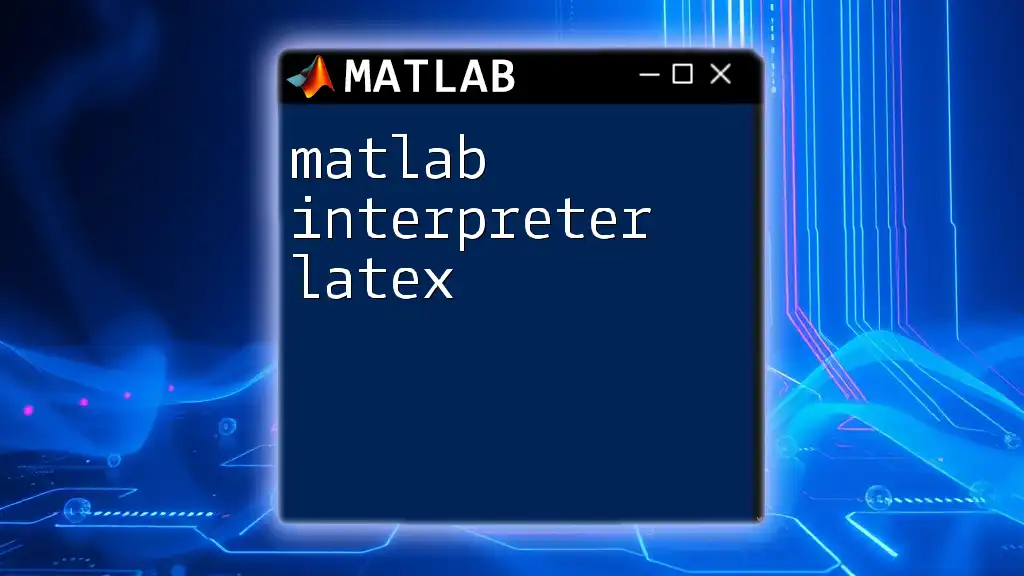The `scatteredInterpolant` in MATLAB is used to perform interpolation on scattered data points, allowing for the estimation of values at query points based on the surrounding data.
Here's a simple code snippet demonstrating its usage:
% Example of using scatteredInterpolant for interpolation
% Generate scattered data
x = rand(100,1) * 10;
y = rand(100,1) * 10;
z = sin(x) + cos(y);
% Create a scattered interpolant
F = scatteredInterpolant(x, y, z);
% Define query points
[qx, qy] = meshgrid(0:0.1:10, 0:0.1:10);
% Evaluate the interpolant at the query points
vq = F(qx, qy);
% Plot the results
figure;
scatter3(x, y, z, 'filled');
hold on;
surf(qx, qy, vq, 'FaceAlpha', 0.5);
title('Scattered Interpolation with scatteredInterpolant');
xlabel('X');
ylabel('Y');
zlabel('Z');
hold off;
What is `scatteredInterpolant`?
The `scatteredInterpolant` function in MATLAB is a powerful tool designed for interpolating scattered data. It effectively estimates values in space based on known data points, providing functionality for both two-dimensional and three-dimensional data. This capability is crucial across various fields such as physics, engineering, and data science, where scattered measurements are commonplace.

Key Features of `scatteredInterpolant`
One notable feature of the `scatteredInterpolant` is its flexibility. Unlike regular grid-based interpolation methods, `scatteredInterpolant` can accommodate arbitrary arrangements of data points. This flexibility allows for accurate interpolation in datasets that are not uniformly distributed, making it suitable for real-world applications.
Types of Methods
The `scatteredInterpolant` supports several interpolation methods, each tailored to different requirements:
-
Linear: Provides a quick and straightforward means of estimating values based on linear combinations of surrounding points. This method is often a good default choice when speed is critical.
-
Nearest: Uses the nearest data point for interpolation, which can be beneficial when the relationship between variables is not linear or when dealing with extremely scattered data.
-
Cubic: Offers a smoother interpolation by fitting cubic polynomials. This method can provide better visual outputs, especially in cases requiring smooth transitions between points.
Understanding which interpolation method best suits your data is key to achieving optimal results with `scatteredInterpolant`.

Creating a `scatteredInterpolant` Object
Creating a `scatteredInterpolant` object requires the following syntax:
F = scatteredInterpolant(X, Y, Z)
Input Arguments Explained
-
X: The x-coordinates of the scattered data points. Must be a vector of the same length as Y and Z.
-
Y: The y-coordinates of the scattered data points, also a vector matching the length of X and Z.
-
Z: The values at the coordinates specified by X and Y. This can represent any scalar field, such as temperature, pressure, or elevation.
It's essential to ensure that these inputs are properly aligned; mismatches will lead to errors.

Example: Simple 2D Interpolation
Setting Up Example Data
To illustrate the usage of `scatteredInterpolant`, let’s generate some scattered data. Here’s how you can set it up in MATLAB:
X = rand(1, 10) * 10;
Y = rand(1, 10) * 10;
Z = sin(X) + cos(Y);
In this code snippet, random x and y values are generated in the range of 0 to 10, while Z is derived from the sine and cosine functions of X and Y. This sets the stage for a simple interpolation scenario.
Creating the Interpolant
After preparing the data, the next step is to create the `scatteredInterpolant` object:
F = scatteredInterpolant(X, Y, Z, 'linear');
This line creates an interpolant using linear interpolation. You can easily switch to other interpolation methods such as 'cubic' or 'nearest' by changing the string provided.
Using the Interpolant
Once the object is created, you can use it to estimate values at specific query points. Here’s how:
queryX = [1, 2, 3]; % Example query points
queryY = [1, 2, 3];
Zq = F(queryX, queryY);
In this example, Zq represents the interpolated Z values at the specified query points.

Visualizing the Interpolation Results
Visualizing interpolated data is fundamental for confirming the accuracy of your interpolation results. You can create a surface plot of the interpolated values using:
[Xq, Yq] = meshgrid(0:0.2:10, 0:0.2:10);
Zq = F(Xq, Yq);
surf(Xq, Yq, Zq);
This code generates a grid of query points (Xq, Yq) and computes Zq using the `scatteredInterpolant` object. The resulting surface plot provides an intuitive understanding of how the interpolated values vary across the grid.

Advanced Usage: Modifying `scatteredInterpolant` Behavior
MATLAB’s `scatteredInterpolant` offers flexibility for advanced users who need to customize their interpolation further.
Changing Interpolation Methods
To modify the interpolation method after creating the object, use the following command:
F.Method = 'cubic';
This command changes the interpolation to cubic, which may yield smoother results at the expense of some computation time.
Setting Extrapolation Method
Additionally, you can change how the interpolant behaves outside the provided data range with the extrapolation method:
F.ExtrapolationMethod = 'nearest';
Choosing an appropriate extrapolation strategy is vital if you plan to query points outside the original data limits.

Performance Considerations
When working with large datasets, performance and memory management become crucial.
Handling Large Datasets
For extensive datasets, consider reducing data dimensionality or using more efficient methods that maintain accuracy without consuming excessive time or resources. MATLAB's efficient handling of arrays and matrices plays a significant role in optimizing performance.
Memory Management
To manage memory effectively while using `scatteredInterpolant`, always verify that your data is of the correct type and size. In cases of repeated calculations, cache results where applicable to avoid recalculating interpolated values unnecessarily.

Common Errors and Troubleshooting
Understanding common errors can save time and frustration:
-
Mismatched Input Lengths: Ensure that X, Y, and Z are all vectors of the same length. Discrepancies will result in runtime errors.
-
Exceeding Data Range: If you attempt to query values outside the defined range without appropriate extrapolation methods set, MATLAB will return an error. Make sure to account for any required extrapolation.
For detailed guidance, consult the official MATLAB documentation or community forums, which often provide real-world solutions to common issues.

Conclusion
The `scatteredInterpolant` function in MATLAB is an incredibly versatile tool for anyone working with scattered data. Its various interpolation methods and capabilities to handle arbitrary datasets open numerous possibilities in data analysis and modeling. Whether you are a beginner exploring interpolation or an advanced user fine-tuning your data processing techniques, diving into the use of `scatteredInterpolant` can significantly enhance your projects.
It's crucial to experiment with different methods and visualization techniques, ensuring that you derive the best insights from your data. Embrace the power of MATLAB and let `scatteredInterpolant` facilitate your journey into the world of data interpolation.

Additional Resources
- For more, refer to the official [MATLAB Documentation on scatteredInterpolant](https://www.mathworks.com/help/matlab/ref/scatteredinterpolant.html).
- Explore suggested tutorials and examples from the MATLAB community to enhance your understanding of interpolation techniques.
- Join MATLAB forums to connect with other users and share your experiences, tips, and tricks regarding the `scatteredInterpolant` and other MATLAB functionalities.

















